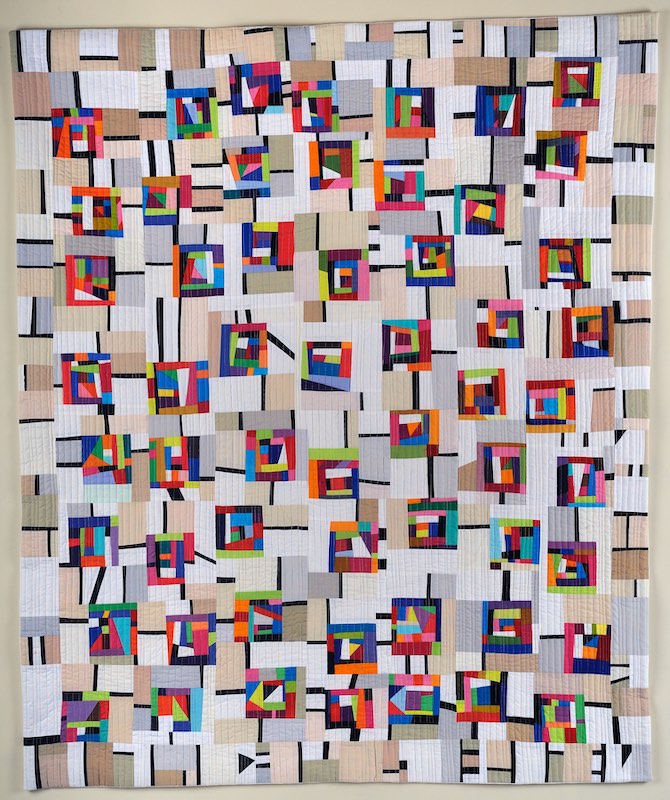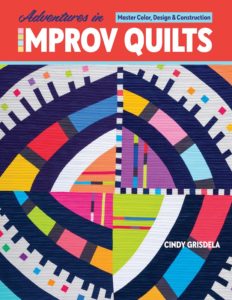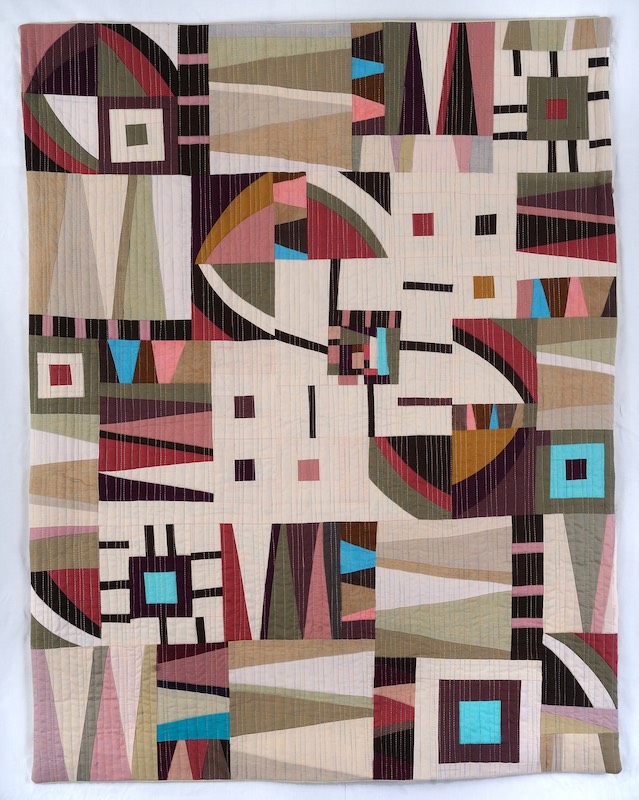With a commitment to creativity as an attribute that develops best when nurtured and encouraged, improv quilt artist, teacher and author Cindy Grisdela works on improving her art quilting skills by doing the work, then doing it again. She emphasizes the same approach with her students – try it, tweak it and try it some more. That’s how you find your strengths and make your voice clearer and clearer, whatever your creative medium.

How did you find yourself on an artist’s path? Always there? Lightbulb moment? Dragged kicking and screaming? Evolving?
I have been interested in art since I was old enough to hold a crayon in my hand. Fortunately, my parents fostered my interest, and I had the opportunity to explore lots of creative pursuits when I was growing up. I majored in art history in college and loved it, but decided that getting a job in that field would be difficult, so I worked for a couple of years and then got an MBA in Finance, because I had an interest in business, too. I worked as a financial journalist in Washington, DC, for a number of years before taking a break to raise my two sons.
Once they were in school, I started playing with fabric and thread more seriously and set myself on a path to evolve from a traditional quilter into a more modern aesthetic that suits me better. I’ve run my own business showing and selling my work, and writing, for about 15 years, combining my love of art and business.
Which artists do you admire? What draws you to their work?
As an Amazon Associate I earn from qualifying purchases. Read more about our affiliate linking policy.
With my degree in art history, there are lots of artists I admire! Henri Matisse is probably at the top of the list, particularly for the cut out collages he created late in his life. I also love the work of Paul Klee for his color and design, and Robert and Sonia Delauney for their color and interesting geometric shapes. In the quilting world, I admire Nancy Crow and the late Gwen Marston, among others. And I love the quilts of Gee’s Bend–they’ve been very inspirational to me.

Why quilting? How does that medium best express what you want to communicate through your art?
I’ve been fortunate to have the opportunity to explore many different art forms, including painting, drawing, sculpture and ceramics. There weren’t any quilters in my family, so I don’t come from a quilting tradition and I didn’t discover quilting until I was in college. I had always loved to sew and made most of my own clothes as a young person, but once I started quilting, I was hooked and stopped making garments.
There’s something about creating something beautiful and useful out of fabric and thread that speaks to my soul. I love the tactile nature of the medium and the fact that I have two opportunities to be creative–first by designing a compelling composition, and then by adding texture with the stitching lines. Few other media allow that combination.
What do you do differently? What is your signature that makes your work stand out as yours?
I’m known for my fearless use of color and my contemporary designs created without patterns or templates.

How do you approach improvisation? What drives your design decisions? Can you tell us about the inspiration and process of one of your works?
My take on improvisation is no patterns, no templates, and no rules, except the self directed guidelines I set for myself at the outset to give some structure to my work.
I engage in a dialogue with my design, so each decision about color, line, and shape influences the next in an organic way. I ask “what if?” a lot and try to always push my designs to be better, not settling for the first solution that presents itself. Many of my pieces start out with a pile of scraps and an idea.
My Color Grid series began from an overflowing bag of scraps. I sorted them roughly by color family and began making 4-inch Improv Log Cabin blocks with no real idea of what they would turn out to be. Each block used an “Anything Goes” color palette and had a bit of white and a bit of black in them. I arbitrarily decided I wouldn’t use yellow.
Once I had a nice selection of blocks, I began arranging them on my design wall. I had a lot of neutral scraps as well, so my original idea was to add neutrals to one or two sides of each block so they could float in an irregular pattern. I did that for a few of them, but it just wasn’t very interesting. So I wondered what would happen if I added some skinny black stripes in the neutral sections, and that made all the difference. The black stripes form a grid for the color blocks to float on top of and it worked.


What is the most important takeaway you want readers to gain from your books, especially your new title, Adventures in Improv Quilts: Master Color, Design & Construction?
I believe that we all have the ability to be creative. Sometimes our creativity gets a little lost in the day to day of life, but it’s always there waiting when you are ready.
I’d like readers to believe that they can create their own original works of art with a few simple guidelines from my books–about color, about technique, and about design, especially Improv design. Because there are no patterns, Improv can be a little intimidating, like you’re working without a net, and I hope my books provide the net to help readers succeed.
What do you do to develop your skills? How do you get better at what you do?
I make a lot of quilts! And I’m always asking myself what I can do to push an idea further by asking those “what if? questions.
Working in series is also helpful to keep my focus on a specific set of design parameters. And teaching helps me get better at my own work, which is something that surprised me a little. In order to teach a subject, you have to know it inside and out, and interacting with students helps me grow as well.

Do you have a dedicated space for creating? If so, what does it look like?
I do have a dedicated studio in my home. We live in a townhouse on a lake and my studio is in the walkout basement of the townhouse, looking out over the lake. I have my design wall set up, my sewing machines within easy reach, and my fabrics stored in wire baskets underneath my cutting table and my ironing station. In addition, I have a full size weaving loom in my studio! I used to weave a long time ago, and I keep thinking that I might get back to it someday.
What are the indispensable tools and materials in your studio? How do they improve your work?
I absolutely love my 60mm rotary cutter, which gives me a lot of control over my freehand cutting techniques. And I’m a huge fan of my Bernina sewing machines–I have a 570 for piecing and a sit down Q20 for free motion stitching. My design wall is a crucial tool, giving me the space to see my work from a distance and leave it up undisturbed during the “marination phase” as I consider the next steps. My wall is made up of squares of foam insulation board that is 1.5″ thick and covered with batting.

Do you use a sketchbook or journal? How does that help your work develop?
I don’t really use either a sketchbook or a journal, although I think it’s a good habit to have. I’m a very intuitive artist and I need to just cut into the fabric and get to work. Occasionally I’ll record a rough sketch or an idea if it will be a while before I can explore it; I don’t want to forget it. But it isn’t anything structured.
What plays in the background while you work? Silence? Music, audiobooks, podcasts, movies? If so, what kind?
When I’m designing, I usually need the quiet around me. But if I’m just sewing or quilting something where the kinks have already been worked out, I sometimes listen to instrumental music like George Winston or Enya.

Tell us about your website. What do you hope people will gain by visiting?
My website is a window into my world; it’s an online gallery where I introduce myself and my work to the public. I have a portfolio section where visitors can see a selection of my work, a blog where I share news and inspiration, a listing of my available lectures and workshops along with a shop where I sell my books and some of my quilts. There’s also a section I call “in situ” where visitors can see pictures of my work in collectors’ homes. That helps them visualize what one of my quilts might look like in an interior space. And visitors have the opportunity to sign up for my monthly newsletter there if they would like to know more.
Like many, you have shifted much of your teaching to online platforms during the Covid pandemic. How has that changed your approach? Do you think you will continue to offer virtual options when it is safe for us to gather in groups? How can students/organizers get in touch with you to schedule an event?
I got up and running to teach online fairly early in the spring of 2020; that’s when I had to cancel my in-person contracts. Many of the guilds and groups that I was scheduled to teach and lecture for could pivot to online options; more were interested in giving it a try. So I was busier in 2020 and 2021 than I had expected to be given the circumstances.
I think there are a lot of benefits to online teaching and lecturing, both for me and for my students. Eliminating travel is a big plus. Dragging two 50 lb. suitcases through an airport is no one’s idea of fun! Plus, students don’t have to lug their machines and their fabric to a central location; and there’s never a line for the iron in an online setting.
Of course we miss the ability to see and touch what others are working on. I expect to continue to offer virtual options as long as there is an interest in them. For small guilds, guilds in places with wintry weather, or guilds in a different part of the country or the world from me, virtual options give us a chance to get together when we otherwise wouldn’t be able to. The best way to contact me to schedule an event is via email at cindy@cindygrisdela.com My available workshops and lectures, plus fee information, are listed on my website at https://www.cindygrisdela.com/workshops-lectures/ And I have several on demand workshops that students can take at their own pace or with a group of friends. More information is available at https://www.cindygrisdela.com/online-learning/

Do you think that creativity comes naturally to people? Or do you think creativity is a skill that people can learn?
Creativity is a learnable skill. It takes practice, but it’s certainly possible to become more creative over time. Although I have explored my own creativity most of my life, I’ve gotten more creative the more I’ve worked at it. We are not all creative in the same way though. I believe we each have our own “quilting DNA” that’s made up of our history, our likes and dislikes, and so on.
For example, I’ve always been drawn to scrappy quilts, both traditional and Improv. I like using lots of colors, asymmetrical designs, and dense free motion quilting that I do myself. But someone else might prefer fewer colors, larger pieces, symmetry in their designs, and hate the quilting part. And that’s OK. It’s important to focus on your strengths and the kind of design that really speaks to you. Then let the rest go. There are no “shoulds” or “have-tos” in my version of Improv!
How can people overcome the challenges they feel to their creative ability?
One thing I say at the beginning of all my Improv classes is, “there’s no way to make a mistake in my class!” You can hear the exhales from students immediately. Especially with Improv, it’s important to let go of the fear that you’re going to do it “wrong.”
Practice is important, and realizing that not every quilt you make is going to be a masterpiece is important, too. You learn from everything, perhaps even more from the quilts that didn’t turn out exactly as you planned than from those that did.
Let go of any expectations; try to cultivate that quiet voice inside that will tell you when a design is working or not. As I like to say, there really is no quilt police that’s going to come and tell you you did it wrong. If it works for you, then it works–and that’s all you need.


How do you get unstuck creatively?
We all get stuck sometimes. I just keep going down to the studio. Sometimes it helps to straighten things up–I’m messy when I’m creating. I play with my scraps a lot when I’m feeling stuck. I just dump them out and start sewing with no real goal in mind. Often a new idea comes from that. Or I take a walk to clear my head. I love this quote that has been attributed to Picasso–“Inspiration exists, but it has to find us working.”
If you could interview a creative person (past or present), who would that person be? What is it about that person that intrigues you?
I would love to interview Georgia O’Keefe. She has always intrigued me in that she went her own way as an artist in a time when it was difficult for a woman to do so. She made the paintings that spoke to her without worrying about whether they would sell or even if anyone would like them.
Interview posted August 2021
Browse through more quilting inspiration and projects on Create Whimsy.
